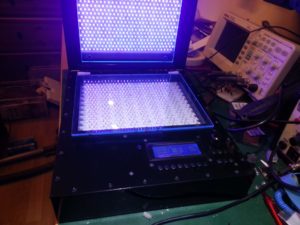Summary
This is a description of how I designed and built my UV exposure box. After experimenting a bit with dry-laminate photo-resist and liquid UV hardened solder mask I decided to stop trying to improve my toner transfer technique and rather build a proper UV radiation unit for making printed circuit boards.
I wanted it to be powerful and compact so I decided to use UV LEDs as the UV source. The preferred wavelength for the LEDs would probably be 365nm, but those LEDs turned out to be hard to find, and very expensive. The 395nm-405nm LEDs on the other hand are very inexpensive. And best of all, can be bough as high-density LED-strip’s on 5-meter rolls. So I bought two “5M Ultraviolet 395nm 3528 SMD LED” rolls that have 120 LEDs per meter for a total of 600 LEDs per roll. From what I could tell from a bit of googling the wavelength should work even though it is not ideal. Initial tests proved that the 395nm LEDs worked very well.
This page (and the unit itself) is still very much work in progress. The CAD files and firmware source code can be found in my github repository.
Features
The UV exposure unit is controlled by an ATmega328P microcontroller and have the following features:
- Single and double sided exposure. Each side radiated by a 594LEDs / 30W UV LED panel (The unit has a total of 1188 LEDs providing 60W of LED light).
- The light panels can be calibrated to give even exposure on both sides.
- Built-in vacuum pump for laminating artwork and copper-clad.
- The user can define 2-18 speed steps for the vacuum pump.
- The vacuum pump can be set to automatically turn off a specified time after the radiation finish.
- Advanced programmable timer / power control for the light panels with 8 persistent presets.
- Each of the presets can in addition be backed up to a “hidden” location and later restored.
- Audible alarm when radiation is complete.
- User input through a rotary knob that also act like a push button plus 15 standalone push buttons.
- User feedback through a 20×4 character backlit LCD display with adjustable backlight and contrast plus a piezo beeper.
- Tracking of runtime. The total on time is tracked. And the runtime of the two light panels and the vacuum pump are tracked with two values each. The absolute time running and the time scaled by the power/speed they where running at.
- Wear balancing of the EEPROM. Some values in the EEPROM is updated fairly often. Like the currently selected preset. And the runtime counters. So each of those values have multiple locations allocated for them in the EEPROM and new values are written to a new location each time until all slots for the value has been used. Then it will start over. This ensures that the guaranteed 100.000 erase/write cycles will last as long as possible.
For more detail: DIY Double Sided 60W LED UV Radiation Unit With Vacuum Pump

